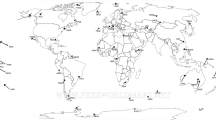Abstract
With the proposition for the adoption of Geocentric Reference System for the Americas (SIRGAS) as a terrestrial reference frame for South America, the need for temporal monitoring of station coordinates used in its materialization has become apparent. This would provide a dynamic characterization of the frame. The Brazilian Network for Continuous Monitoring of GPS (RBMC) has collected high accuracy GPS measurements since 1996. The Brazilian Institute of Geography and Statistics (IBGE) maintains this network in collaboration with several universities and organizations. Most of the stations are also part of the SIRGAS network. The RBMC also contributes data to the International Terrestrial Reference System (ITRS) to densify the global frame. Two of the RBMC stations are also part of the International GPS Service (IGS). This paper reports initial results from these stations. To estimate the velocity field defined by these stations, ten IGS stations located on the border of the South American plate and in adjacent plates, along with nine RBMC stations, were used. Observations covering five groups of 15 days each were used. These groups of observations were at epochs 1997.3, 1997.9, 1998.3, 1998.9 and 1999.2. Seven IGS stations were chosen to have their coordinates constrained to those epochs. IGS products (precise ephemeris and clocks) were used to process the daily solutions, which were carried out with Bernese software. Carrier phase double differences were formed using the ionospheric-delay free observable. The troposphere was modeled using a combination of the Saastamoinen model and the Niell mapping function. A tropospheric parameter was estimated every two hours. The results of the daily baseline solutions were combined using the summation of normal equations technique, in which the final coordinates and velocities were estimated. The results were compared with various models, such as the NNR-NUVEL1 and the APKIM8.80. Velocity vectors estimated for the RBMC stations show good agreement with those two models, with rates approximately equal to 2 cm/year.



Similar content being viewed by others
References
Argus DF, RG Gordon (1991) No-net-rotation model of current plate velocities incorporating plate motion model NUVEL-1. Geophys Res Lett 18(11):2039–2042
Boucher C, Altamimi Z, Sillard P(1998) The ITRF96 realization of the International Terrestrial Reference System. Proceedings of the International Association of Geodesy Scientific Assembly, Rio de Janeiro, Brazil, September, 1997
Caporali A, Martin S, Massironi M (2000) Constraining the contemporary crustal deformation in Italy with geodetic data. Reports on Geodesy, vol 54, No 8, Warsaw Institute of Technology, Poland, pp 179–193
DeMets C, Gordon RG, Argus DF, Stein S (1990) Current plate motions. Geophys J Int 101:425–478
DeMets C, Gordon RG, Argus DF, Stein S (1994) Effect of recent revisions to the geomagnetic reversal time scale on estimates of current plate motions. Geophys Res Lett 21(20):2191–2194
Dietrich R, Dach R, Engelhardt G, Ihde J, Knorth W, Kutter H-J, Lindner K, Mayer M, Menge F, Miller H, Müller C, Niemier W, Perlt J, Pohl M, Salbach H, Shenke H-J, Shöne T, Seeber G, Veit A, Völksen C (2000) ITRF coordinates and plate velocities from repeated campaigns in Antarctica— an analysis based on different individual solutions. J Geod 74:756–766
Drewes H (1982) A geodetic approach for the recovery of global kinematic plate parameters. Bull Geod 56:70–79
Drewes H (1993) Global and regional deformation models of the earth's surface. Proceedings of the International Conference on Cartography and Geodesy, 24 November–3 December 1992, Maracaibo, Venezuela
Drewes H (1998) Time evolution of the SIRGAS reference frame. Proceedings of the International Association of Geodesy Scientific Assembly, September, 1997, Rio de Janeiro, Brazil, pp 175–179
Drewes H, Angermann D (2001) The actual plate kinematic and crustal deformation model 2000 (APKIM 2000) as a geodetic reference system. In: Book of Abstracts, International Association of Geodesy General Assembly, 2–7 September, Budapest, Hungary
Hugentobler U, Schaer S, Fridez P (2001) Bernese GPS Software Version 4.2. Astronomical Institute, University of Berne, Berne, Switzerland, 127 pp
IBGE (1997) SIRGAS bulletin. Department of Geodesy, Instituto Brasileiro de Geografia e Estatística, Rio de Janeiro, Brazil, September, 1997
Kreemer C, Holt WE (2001) A no-net-rotation model of present-day surface motions. Geophys Res Lett 28(23):4407–4411
Larson KM, Freymueller JT Philipsen S (1997) Global plate velocities from global positioning system. J Geophys Res 102 (B5):9961–9981
McCarthy DD (1996) IERS technical note 21. International Earth Rotation Service, Observatoire de Paris, Paris
Sella, G F, Dixon TJ Mao A (2002) REVEL: a model for recent plate velocities from space geodesy. J Geophys Res 107(4):1
United Nations (2001) Recommendations from the Seventh Cartographic Conference for the Americas, January, 2001, New York, pp 22–26
Vaníček P, Cross PA, Hannah J, Hradilek L, Kelm R, Mäkinen J, Merry CL, Sjöberg LE, Steeves RR, Zoloski DB (1988) Four-dimensional geodetic positioning. Manuscr Geodaet 12(3):147–222
Xu C, Liu J, Chao D, Shi C, Chen T, Li Y (2000) Preliminary study of block rotation model in North China area using GPS measurements. In: Schwarz K-P (ed) Geodesy beyond 2002, Proceedings of the International Association of Geodesy Symposia, January, 2001. Springer, Berlin Heidelberg New York, pp 295–303
Acknowledgments
We would like to acknowledge financial support from the following agencies: the Brazilian agency CAPES, the German agency DAAD, and the Canadian agency NSERC. We would also like to thank anonymous reviewers for their comments.
Author information
Authors and Affiliations
Corresponding author
Rights and permissions
About this article
Cite this article
Alves, S.M.C., Santos, M.C. & Gemael, C. A velocity field estimation of the Brazilian portion of the SOAM plate. GPS Solutions 7, 186–193 (2003). https://doi.org/10.1007/s10291-003-0062-6
Received:
Accepted:
Published:
Issue Date:
DOI: https://doi.org/10.1007/s10291-003-0062-6




